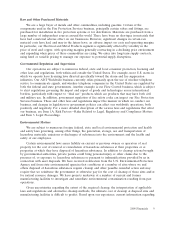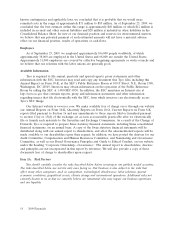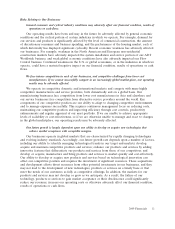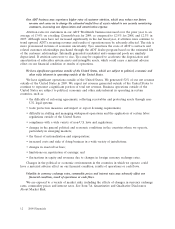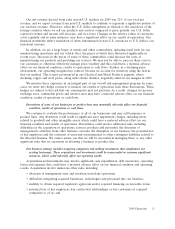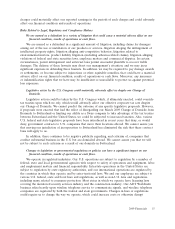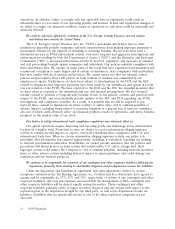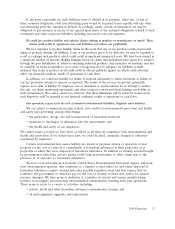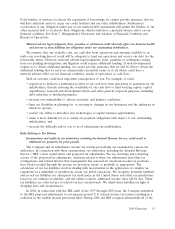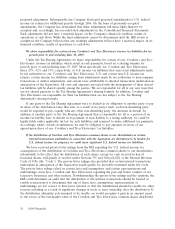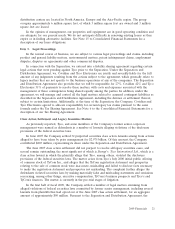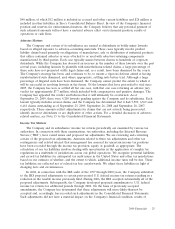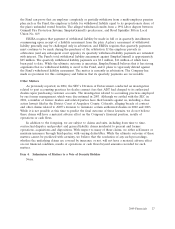ADT 2009 Annual Report Download - page 110
Download and view the complete annual report
Please find page 110 of the 2009 ADT annual report below. You can navigate through the pages in the report by either clicking on the pages listed below, or by using the keyword search tool below to find specific information within the annual report.These projects involve both remediation expenses and capital improvements. In addition, we remain
responsible for certain environmental issues at manufacturing locations previously sold by us.
The ultimate cost of cleanup at disposal sites and manufacturing facilities is difficult to predict
given uncertainties regarding the extent of the required cleanup, the interpretation of applicable laws
and regulations and alternative cleanup methods. Based upon our experience, current information
regarding known contingencies and applicable laws, we concluded that it is probable that we would
incur remedial costs of approximately $40 million, of which $12 million is included in accrued and other
current liabilities and $28 million is included in other liabilities in the Consolidated Balance Sheets as
of September 25, 2009. Environmental laws are complex, change frequently and have tended to become
more stringent over time. While we have budgeted for future capital and operating expenditures to
maintain compliance with such laws, we cannot provide assurance that our costs of complying with
current or future environmental protection and health and safety laws, or our liabilities arising from
past or future releases of, or exposures to, hazardous substances will not exceed our estimates or
materially adversely affect our financial condition, results of operations or cash flows. We may also be
subject to material liabilities for additional environmental claims for personal injury or cleanup in the
future based on our past, present or future business activities or for existing environmental conditions
of which we are not presently aware.
Risks Related to Our Liquidity
Recent disruptions in the financial markets could have adverse effects on us, our customers and our
suppliers, as access to liquidity may be negatively impacted by disruptions in the credit markets,
leading to increased funding costs or unavailability of credit.
In the normal course of our business, we access credit markets for general corporate purposes,
which may include repayment of indebtedness, acquisitions, additions to working capital, repurchase of
common shares, capital expenditures and investments in the Company’s subsidiaries. Although we
believe we have sufficient liquidity to meet our current needs, our access to and the cost of capital
could be negatively impacted by disruptions in the credit markets. In 2009, global credit markets
experienced significant dislocations and liquidity disruptions, and continued uncertainty in the credit
markets may make financing terms for borrowers unattractive or unavailable. These factors may make
it more difficult or expensive for us to access credit markets to meet our needs. In addition, these
factors may make it more difficult for our suppliers to meet demand for their products or for
prospective customers to commence new projects, as customers and suppliers may experience increased
costs of debt financing or difficulties in obtaining debt financing. These disruptions in the financial
markets have had adverse effects on other areas of the economy and have led to a slow down in
general economic activity that we expect to continue to adversely affect our businesses. These
disruptions may have other unknown adverse affects. Based on these conditions, our profitability and
our ability to execute our business strategy may be adversely affected.
Covenants in our debt instruments may adversely affect us.
Our bank credit agreements contain financial covenants, including a limit on the ratio of debt to
earnings before interest, taxes, depreciation, and amortization and limits on incurrence of liens and
subsidiary debt. Our indentures contain customary covenants including limits on negative pledges,
subsidiary debt and sale/leaseback transactions.
Although we believe none of these covenants are restrictive to our operations, our ability to meet
the financial covenants can be affected by events beyond our control, and we cannot provide assurance
that we will meet those tests. A breach of any of these covenants could result in a default under our
credit agreements or indentures. Upon the occurrence of an event of default under any of our credit
facilities or indentures, the lenders or trustees could elect to declare all amounts outstanding
thereunder to be immediately due and payable and terminate all commitments to extend further credit.
18 2009 Financials



